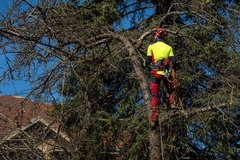
Trees that are not adequately prepared for storms can suffer significant damage, posing threats not only to themselves but also to nearby structures and people. In this blog post, we will discuss essential tips and tricks on storm-proofing your trees.
From understanding warning signs to practical maintenance tips, we aim to empower you with the tools to actively protect your surroundings.
By the end of this article, you'll have a firm grasp of how to manage tree care costs effectively, use budget-friendly strategies, and when to call in professionals like those at First Choice Tree Care.
Why Storm-Proofing is Essential
Foundation of Safe Landscaping
Trees are nature's giants, giving us shade, oxygen, and beauty. However, in regions prone to heavy storms, these assets can quickly become liabilities. High winds, heavy rains, and snow loads can stress even the healthiest trees.
In early April this year, a storm in Mosinee uprooted several trees, causing significant damage to properties. These incidents highlight the need for proactive measures in tree care. Such events serve as a stark reminder of the possible consequences of neglecting storm-proofing.
The Consequences of Inaction
Ignoring the need for preventative measures can lead to costly repercussions. Not only can damaged trees bring down power lines, but they can also damage roofs, windows, and vehicles.
Furthermore, an unchecked weak branch might threaten the safety of your family or neighborhood. The financial burden of repairing storm damage often far exceeds the cost of preventive tree care, making storm-proofing not just wise but also practical in the long term.
Assessing Your Trees: Recognizing Warning Signs
Early Detection Saves Trees
Assessing your trees only requires a sharp eye and some basic knowledge. Keep an eye out for dead branches, cracks in the trunk, fungus, and an uneven canopy. These signs indicate potential weaknesses that could worsen during storms.
- Deadwood: Branches that are no longer living are the most susceptible to high winds. They can become projectiles, causing harm to property and individuals.
- Canopy Imbalance: An uneven canopy due to extensive pruning or natural growth can lead to instability. Trees strive for balance and when it's disrupted, they become more vulnerable to falling over.
- Trunk Cracks: Fissures and splits in the trunk might suggest internal decay. Often, trees with damaged trunks have reduced structural integrity.
Implementing a regular check-up routine can save you from serious repercussions. You don't have to face this task alone.
Consider reaching out to the local experts at First Choice Tree Care, who can offer professional assessments and create storm-proofing plans tailored to your needs.
The Role of Visual Inspections
Use a pair of binoculars for a close look at the upper sections of taller trees. This technique often reveals issues that are otherwise invisible from the ground.
For mature trees or those near homes, a deeper inspection by professionals can reveal interior issues not visible externally.
Proven Techniques for Storm-Proofing
Pruning: Your First Line of Defense
Effective pruning is fundamental in reducing a tree's vulnerability to storm damage. A well-pruned tree has fewer dead branches, thus less weight and wind resistance.
- Remove Vulnerable Branches: Focus on pruning deadwood and any branches that seem fragile or are rubbing against others.
- Encourage Healthy Structure: Prune in a manner that supports strong, central growth. This ensures the tree can withstand high winds better.
- Engage Professionals for High-Risk Pruning: For significant pruning tasks, calling a certified arborist is advisable. They can ensure that the tree remains healthy and its structural integrity is improved, not compromised.
Cabling and Bracing: Strengthening the Framework
If your landscape contains older trees with historic value or sentimental attachment, cabling and bracing become indispensable. These techniques involve rods and cables to lend additional support to branches prone to splitting.
- Prevent Limb Failure: By joining the branches, you are redistributing the load during adverse weather, which can lower the chances of limb failure.
- Minimize Movement: These supports reduce excessive movement during storms, which is often the cause of significant damage.
Soil Management: The Roots of Resilience
Healthy roots ground your trees both physically and metaphorically. Trees with strong root systems are inherently more resistant to storm damage.
- Proper Mulching: Apply mulch around the base of trees to retain moisture and ensure root aeration. This practice insulates roots, keeping them healthy.
- Avoid Overwatering: Excess water can erode root integrity, making trees more susceptible to toppling. Take care to maintain a well-drained soil condition.
Conclusion
Storm-proofing your trees is an investment in the safety and beauty of your environment. By regularly assessing your trees and applying practical strategies like pruning, cabling, and soil management, you're actively protecting your property from potential storm damage.
Take the time today to evaluate your trees' health, and consider reaching out to First Choice Tree Care for a professional assessment or to enhance your DIY efforts.
You may contact our team directly for expert advice and services-or get started on a free consultation to assess your tree care needs today. Remember, proactive care today equals fewer repairs tomorrow.
